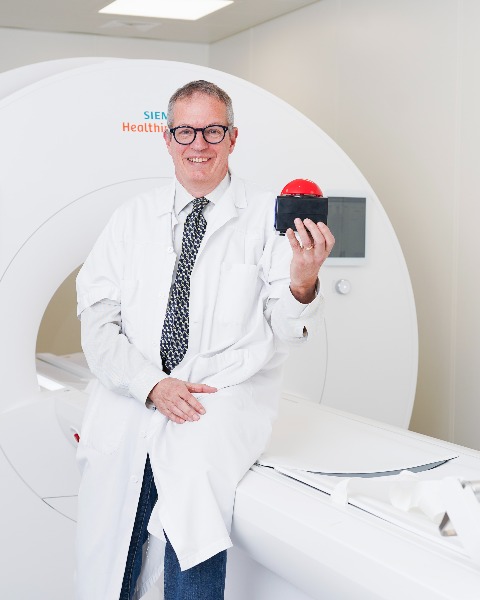Oral Abstract
One-click joint bright- and black-blood late gadolinium enhancement and T2 mapping for advanced myocardial imaging in the acute STEMI population
- Vd
Victor de Villedon de Naide, MSc
PhD student
Bordeaux University - INSERM U1045, France - Vd
Victor de Villedon de Naide, MSc
PhD student
Bordeaux University - INSERM U1045, France - EG
Edouard Gerbaud, MD, PhD
Cardiac Intensive Care Unit, Groupe Hospitalier Sud, CHU de Bordeaux, Pessac, France, France
- bd
baptiste durand, MD, PhD
Radiologist
Department of Cardiovascular Imaging, Hôpital Cardiologique du Haut-Lévêque, CHU de Bordeaux, Avenue de Magellan, 33604 Pessac, France, France - MV
Manuel Villegas-Martinez, PhD
Postdoctoral Student
Bordeaux University - INSERM U1045, France - KN
Kalvin Narceau, MSc
Research Engineer
Bordeaux University - INSERM U1045, France - KH
Kun He, PhD, MSc
Engineer
IHU LIRYC, Heart rhythm disease institute, Université de Bordeaux – INSERM U1045, Avenue du Haut Lévêque, 33604, Pessac, France, France - RK
Rabea Klaar, PhD, MSc
Post doctorant
Comprehensive Pneumology Center (CPC-M), Member of the German Center for Lung Research (DZL), Munich, Germany, Germany - tG
thais Génisson, MSc
PhD student
IHU LIRYC, Heart rhythm disease institute, Université de Bordeaux – INSERM U1045, Avenue du Haut Lévêque, 33604, Pessac, France, France - TR
Théo Richard, MSc
Engineer
IHU LIRYC, Heart rhythm disease institute, Université de Bordeaux – INSERM U1045, Avenue du Haut Lévêque, 33604, Pessac, France, France - PG
Pauline Gut, MSc
PhD student
University Hospital (CHUV) and University of Lausanne (UNIL), Switzerland - AS
Albrecht Ingo Schmid, PhD, MSc
Professor
Center for Medical Physics and Biomedical Engineering, High Field MR Center, Medical University of Vienna, Vienna, Austria, Austria - CB
Claire Bazin
MD
Centre Hospitalier Universitaire de Bordeaux, France - IB
Ilyes Benlala
MD-PhD
Centre Hospitalier Universitaire de Bordeaux, France - PJ
Pierre Jaïs, MD, PhD
PROF/PhD
Hôpital Cardiologique du Haut-Lévêque, CHU de Bordeaux, France 
Mathias Stuber, PhD
Full Professor
CIBM-CHUV-UNIL
Laussane University, Switzerland- HC
Hubert Cochet, MD, PhD
Professor
Department of Cardiovascular Imaging, Hôpital Cardiologique du Haut-Lévêque, CHU de Bordeaux, France 
Aurelien Bustin, PhD
Assistant Professor
IHU LIRYC, France
Presenting Author(s)
Primary Author(s)
Co-Author(s)
Cardiac magnetic resonance (CMR) imaging enables post-infarction risk stratification by identifying independent prognostic markers, such as infarct size (IS) and the presence of microvascular obstruction (MVO) using late gadolinium enhancement (LGE), ejection fraction measurements via CINE, and area-at-risk (AAR) and myocardial salvage (MS) assessment through T2 mapping1–3. However, employing these distinct sequences implies complex planning, repetitive breath-holds, and complicated post-processing analysis due to sub-optimal bright-blood LGE contrast and poorly co-registered images.
Here we propose a unified ‘one-click’ sequence that collects co-registered black- and bright-blood LGE images and T2 maps for seamless planning, fast acquisition, and enhanced image quantification and analysis in the acute STEMI population.
Methods:
The proposed 2D whole-heart SPOT-MAPPING acquisition (Fig.1) consists of a single-shot breath-held ECG-triggered bSSFP sequence collecting in an interleaved fashion five black-blood images using an inversion recovery pulse with a T2 preparation module and five bright-blood shots using only a T2 module with increasing preparation times. Four sets of co-registered images are reconstructed: (i) averaged black-blood for scar detection; (ii) averaged bright-blood for scar localization and left ventricular (LV) wall segmentation; (iii) fusion of both for coloured scar representation and MVO detection; (iv) T2 map for AAR and MS measurements.
Experiments: 7 patients with acute STEMI underwent CMR (1.5T Siemens). Pre-contrast T2 maps, and post-contrast PSIR4, SPOT5 and SPOT-MAPPING images were collected in a random order 12min after injection of gadolinium. LV wall and scar contours were drawn by a radiologist using Circle CVI42. AAR, IS, MS index and MVO were defined according to literature6,7, along with T2 values in remote and injured myocardium. The IS mass and burden (SPOT-MAPPING vs. PSIR) and AAR (SPOT-MAPPING vs. T2 mapping) were compared using the Wilcoxon signed-rank test. The concordance between T2 values (SPOT-MAPPING vs. T2 mapping) was conducted using a paired t-test. Acquisition times were recorded.
Results:
An example of SPOT-MAPPING images in a patient with acute STEMI is seen in Fig.2A. Prognostic markers obtained with the proposed sequence are shown in Fig.2B for 4 patients. Acquisition times for PSIR, SPOT, T2 mapping and proposed SPOT-MAPPING were 10, 10, 13 and 10 heartbeats per slice, respectively. No significant differences were found between SPOT-MAPPING and the reference PSIR for IS (24.8±8.9 vs. 23.1±8.0, P=0.214) and between SPOT-MAPPING and T2 mapping for AAR (67.1 [63.1-76.1] vs. 67.7 [61.8-72.5], P=0.813), and for T2 values across the noninfarcted, infarcted, and salvage myocardium (P >0.05, Fig.3). By imaging both the infarct scar and the area-at-risk in a co-registered fashion, SPOT-MAPPING enabled the measurement of the MS index (71% [56-74]) and the MVO which could be prognostic markers for post-infarct complications.
Conclusion:
The ‘one-click’ SPOT-MAPPING sequence enables easy planning, rapid acquisition, and enhanced image quantification and analysis for patients with acute STEMI. Further validation in larger cohort is warranted.
Schematic overview of the proposed “one-click” breath-held joint bright-blood, black-blood, and T2 mapping sequence (SPOT-MAPPING). During odd heartbeats, a 180° inversion pulse is followed by an adiabatic T2 preparation module, generating a black-blood contrast ideal for scar detection. In even heartbeats, only the T2 module is activated, resulting in bright-blood contrast tailored for scar localization. The preparation time for the T2 module is progressively increased across the five bright-blood shots ([0, 27, 35, 40, 55] ms), allowing for the extraction of a T2 map through curve fitting for precise quantification of the area-at-risk and myocardial salvage. A dedicated TI-scout was performed prior to LGE imaging. Imaging parameters included: 5 signal averages, 1.4mmx1.4mm in-plane resolution, 8mm slice thickness, FA=60°, GRAPPA x2, ~160ms acquisition window, TE/TR=1.2/2.8ms, bandwidth=870Hz/pixel, inversion time determined from a prior scout acquisition..jpg)
A) Illustrative images collected from base to apex using the reference phase-sensitive inversion recovery (PSIR) and the proposed joint bright- and black-blood and T2 map (SPOT-MAPPING) sequences in a patient with acute STEMI. B) Images of mid-ventricular slices for four acute STEMI patients. In a single sequence, SPOT-MAPPING provides a comprehensive assessment of heart tissue, such as microvascular obstruction, infarct size and myocardial salvage, for effective risk stratification. Abbreviations: IS, infarct size; MSi, myocardial salvage index; MVO, microvascular obstruction..jpg)
CMR findings in pre-contrast T2 map, phase-sensitive inversion recovery (PSIR) and the proposed joint bright- and black-blood and T2 map (SPOT-MAPPING) images. On LGE images, infarct size (IS) was quantified as myocardium with signal intensity exceeding a threshold set by the experienced radiologist. On T2 mapping images, the area-at-risk (AAR) was defined as the presence of oedema in the myocardium. A region of interest was drawn in the remote myocardium, and oedema was quantified as myocardium with T2 value superior to 2 standard deviations of remote myocardium. Myocardial salvage index was calculated as the ratio of the myocardial salvage to the area at risk. Myocardial salvage was obtained after subtracting the IS from the AAR..jpg)

